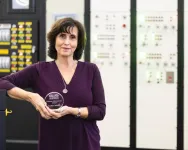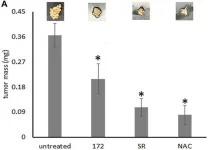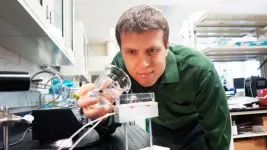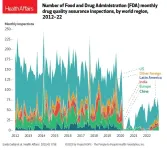(Press-News.org) You see posts like these on neighborhood Facebook pages all the time: “An owl just flew into my window and appears stunned! Help!” or “I found a baby squirrel on the ground after the wind storm last night. Who do I call?” The answer is a local wildlife rehabilitation center—licensed individuals and organizations that take in hundreds of thousands of sick and injured wild animals nationwide each year. Wildlife rehabilitators see the highest number and greatest range of species of any government or nonprofit organization in the country, giving them unique insight into animal health—and making them great bellwethers of what’s happening in the broader environment.
A few years ago, biologist Tara Miller (GRS’22)—then working with Defenders of Wildlife—met Wendy Hall, cofounder of the Adirondack Wildlife Refuge in Wilmington, N.Y. Hall mentioned some weird occurrences she had noticed in her job over the last few years: black vultures in the Adirondacks, unusual since they are typically a southern species, and earlier “baby seasons” in many species, which researchers have linked to climate change. Miller was intrigued by the idea of using animals’ presence in rehab centers to study the impact of people and climate change on North America’s wildlife.
Miller (who uses they/them pronouns) is the lead author of a first-of-its-kind study that compiled hundreds of thousands of records from 94 wildlife centers across the United States and Canada to investigate the threats facing more than a thousand wildlife species by region—including which threats affect which animals and how effective wildlife rehab centers are at treating their patients. The Boston University–led team hopes their study, published in Biological Conservation, will help inspire safety interventions and inform the conversation about incorporating wildlife into disaster management plans.
The report includes examples of bald eagles sickened by lead poisoning, sea turtles entangled in fishing gear, and big brown bats colliding with buildings. In other words, human activities often have a devastating impact on wildlife, Miller says. What’s more, the researchers showed that more animals were admitted to wildlife rehab centers following some climate change–linked extreme weather events.
“A lot of what we found in the research isn’t going to shock anyone, but you want to be able to tell people, ‘It’s not just this one animal. This is happening across the country,’” Miller says. “I think that was what was so cool about the work we were able to do with this huge dataset: tie together what rehabbers across the country are seeing and validate it. We were able to find a lot of these trends for the big picture of how humans are impacting wildlife.”
The Major Threats to Wildlife
Miller started in BU’s Urban Biogeoscience and Environmental Health (BU URBAN) program in 2018. Funded by the National Science Foundation, BU URBAN trains PhD students in biogeoscience, environmental health, and statistics, giving them the foundation to enter careers in academia, government agencies, NGOs, and the private sector.
The program requires internships, so in summer 2019, Miller began contacting wildlife centers, which varied in size from those rescuing a few hundred animals a year to groups helping tens of thousands. Miller asked what trends they noticed and what questions they would like answered through any report.
“I had phone calls with rehabbers where they would have to jump off because they had a baby squirrel they had to go feed, or one time someone had a porcupine autopsy they had to get back to,” Miller says. “People were so generous with their time and of their data, and so enthusiastic about this whole project.”
Until recently, most wildlife rehab records existed only in binders and file cabinets, which made them inaccessible to researchers. But slowly, over the last decade or so, centers have started to digitize their documents, thanks in part to software such as the Wildlife Center of Virginia’s WILD-ONe patient database system for wildlife rehabilitators. WILD-ONe was formed, in part, to help identify wildlife diseases and pathogens—such as West Nile virus or avian flu—that might impact human and livestock health. The software was the biggest data source for Miller’s paper; two of the paper’s coauthors, Karra Pierce and Edward Clark, Jr., work at the Wildlife Center of Virginia.
“This was a gigantic dataset, with more than 600,000 observations,” says Richard Primack, a BU College of Arts & Sciences professor of biology, who was Miller’s PhD advisor and a coauthor on the paper. Primack says he encourages all of his students to consider what questions they want their data to address. In Miller’s case, the big question was, “What are the major threats to wildlife?”
The data revealed that 40 percent of animals were sent to rehab centers because of injuries classified under the “human disturbances” category. These included vehicle accidents, building collisions, and fishing incidents. “Forty percent of the animals showing up to wildlife rehab centers, largely because of human activity that has negatively impacted them?” Miller asks incredulously. “We need to ask how we can change our policies and behaviors to impact animals less.”
Seasonally speaking, the researchers found vehicle collisions were highest from May to July and disproportionately affected reptiles. Pesticide poisonings increased in the spring, summer, and early fall, a time of more agricultural and construction activity. Lead poisonings (most common in animals like bald eagles) tended to be seen in the winter, after hunting season. Many hunters still use lead ammunition when deer hunting, which will then poison scavengers like bald eagles and vultures when they go in for a snack on a carcass.
Through their discussions, many rehabbers told Miller they knew they weren’t catching all cases of lead and pesticide poisoning since the testing is so expensive and they can’t send every suspected case out.
The researchers also found more animals arrived at rehab centers the week after extreme weather events than the week before—following hurricanes and floods in southern Florida, for example. They have also seen more animals admitted after big storms in recent years, “possibly due to the increasing intensity and frequency of extreme weather events,” the study says.
“We are seeing the impacts of these climate change–driven extreme weather effects on animals,” Miller says. “So, should we be thinking about that in terms of disaster and response plans? Do we need to boost state funding to centers to be able to care for animals after these big events?”
About one-third of the animals brought into wildlife rehab centers are eventually released back into the wild, though this number varies significantly among species. “For example, pelicans are injured but then are often released [68 percent], whereas bald eagles have a very low chance of being released [20 percent],” Primack says. “This presents a very interesting question of why the threats to wildlife are so different between these two groups of large birds.”
Recommending New Policy, Based on the Data
The team hopes their study can be used by wildlife rehab centers when they apply for grants and funding, and can convince communities to make some fairly easy changes to protect animals. Wildlife underpasses and overpasses across roads can help deer and turtles cross a highway safely (also reducing car accidents), adding decals and other patterns to windows can save birds, and educating the public on how to phase out lead fishing gear and hunting ammunition can cut down on poisoning in scavengers. Some states also have lead ammunition buy-back programs, Miller says. These changes will help humans too. Deer-car collisions are not only expensive to fix, but can also be deadly for all parties.
After graduating from BU in May 2022, Miller started work as a policy research specialist at the University of Virginia’s Repair Lab, studying and developing policy solutions to coal dust pollution that affects predominantly Black communities near coal export terminals in coastal Virginia. “Tara is now focused on applied work helping people, using many of the skills acquired as a grad student while investigating wildlife health on a continental scale,” Primack says. “It’s really pretty fantastic.”
This work was supported by the National Science Foundation Research Traineeship–funded Boston University graduate program in Urban Biogeoscience and Environmental Health.
END
New study identifies the greatest threat to wildlife across North America and Canada: people
BU biology student studied more than 600,000 wildlife rehabilitation center records to look at the human impact on wild animals, from lead poisonings to window strikes to vehicle collisions
2023-12-04
ELSE PRESS RELEASES FROM THIS DATE:
ORNL engineer Karen White honored with Lifetime Achievement Award
2023-12-04
Oak Ridge National Laboratory’s Karen White, who works in ORNL’s Neutron Science Directorate, has been honored with a Lifetime Achievement Award.
White, who manages the section that provides the machine controls,, computing infrastructure, and protection systems across all neutron science technical areas, received the award during the biennial International Conference on Accelerator and Large Experimental Physics Control Systems, held October 7-13, 2013, in Cape Town, South Africa. The award by ICALEPCS honors and celebrates an individual or individuals ...
Osteopontin induces mitochondrial biogenesis in deadherent cancer cells
2023-12-04
“Here, we study the induction of mitochondrial biogenesis by Osteopontin variants in deadherent breast tumor cells.”
BUFFALO, NY- December 4, 2023 – A new research paper was published in Oncotarget's Volume 14 on December 1, 2023, entitled, “Osteopontin induces mitochondrial biogenesis in deadherent cancer cells.”
Metastasizing cells display a unique metabolism, which is very different from the Warburg effect that arises in primary tumors. Over short time frames, oxidative phosphorylation and ATP generation are prominent. Over longer time frames, mitochondrial biogenesis becomes a pronounced ...
Boiled bubbles jump to carry more heat
2023-12-04
Water is often the go-to resource for heat transfer, being used in large-scale cooling operations like data centers that power the internet and nuclear power plants that power cities. Discovering dynamic phenomena to make water-based heat transfer more energy and cost efficient is the ongoing work of Jonathan Boreyko, associate professor and John R. Jones III Faculty Fellow in mechanical engineering.
Boreyko and his team have published extensively on the topic of water and the way it can move, with members of his Nature-Inspired ...
Increase in child suicide linked to the nation’s opioid crisis
2023-12-04
The rise in child suicides in the U.S. since 2010 was fueled in part by the nation’s opioid crisis, which previous studies found increased rates of child neglect and altered household living arrangements, according to a new RAND Corporation study.
The analysis links the rise is child suicides to the reformulation of prescription opioids to discourage misuse, which led to a steep rise in the use of illicit opioids such as heroin and may have contributed to the growth of illicit opioid markets.
Geographic areas that were more exposed to ...
UCLA scientists receive $9.1 million from the NCI to improve early detection methods for cancer
2023-12-04
Researchers from the UCLA Health Jonsson Comprehensive Cancer Center have received two grants totaling $9.1 million from the National Cancer Institute to advance liquid biopsy technologies for the early detection of cancer, which can significantly improve treatment outcomes and reduce the number of deaths caused by the disease.
A liquid biopsy is a promising non-invasive medical test using a small volume of blood that gives scientists insight into the genetic makeup of tumors. By analyzing these components, researchers can gain valuable information about the genetic mutations, alterations and other molecular changes associated ...
Health Affairs’ December Issue: Global Lessons From COVID-19
2023-12-04
Washington D.C.—The December Health Affairs, a theme issue about the lessons learned around the globe from the COVID-19 pandemic, covers topics including how modeling was used to respond to the pandemic, how health inequities emerged and were addressed, and how countries tried to protect their vulnerable residents. The December issue of Health Affairs was supported by the Robert Wood Johnson Foundation and the Merck Foundation.
There will be a Health Affairs briefing on Tuesday, December 5, from 11:00 a.m. to 2:00 p.m. ET. Register here.
COVID-19, a decline in FDA foreign facility inspections.
At the start of the COVID-19 pandemic, the Food and Drug Administration (FDA) halted ...
BioOne announces Subscribe to Open Pilot
2023-12-04
WASHINGTON D.C. – BioOne, the leading nonprofit aggregator in the biological, ecological, and environmental sciences, today announces a bold plan to offer up to 80 society titles as part of a Subscribe to Open (S2O) pilot beginning in January 2026.
This decision, unanimously endorsed by the BioOne Board of Directors, follows 18 months of careful feasibility analysis and extensive interviews with BioOne’s community of society and library partners in search of an equitable and sustainable path to open.
BioOne will work with its publishing community throughout 2024 to encourage participation in the pilot, ...
Unveiling a new era of imaging: Boston University engineers lead breakthrough microscopy techniques
2023-12-04
When microscopes struggle to pick up faint signals, it’s like trying to spot subtle details in a painting or photograph without your glasses. For researchers, this makes it difficult to catch the small things happening in cells or other materials. In new research, Boston University Moustakas Chair Professor in Photonics and Optoelectronics, Dr. Ji-Xin Cheng and collaborators are creating more advanced techniques to make microscopes better at seeing tiny sample details, without needing special dyes. Their results, published in Nature Communications and Science Advances respectively, are helping scientists visualize and understand their samples in an easier ...
New wearable communication system offers potential to reduce digital health divide
2023-12-04
Wearable devices that use sensors to monitor biological signals can play an important role in health care. These devices provide valuable information that allows providers to predict, diagnose and treat a variety of conditions while improving access to care and reducing costs.
However, wearables currently require significant infrastructure – such as satellites or arrays of antennas that use cell signals – to transmit data, making many of those devices inaccessible to rural and under-resourced communities.
A group of University of Arizona researchers has set out to change that with a wearable monitoring device system that can send ...
In hotter regions, mammals seek forests, avoid human habitats
2023-12-04
The cool of the forest is a welcome escape on a hot day. This is especially true for mammals in North America’s hottest regions, according to a study from the University of California, Davis. The study indicates that, as the climate warms, preserving forest cover will be increasingly important for wildlife conservation.
The study, published today in the journal PNAS, found that North American mammals — from pumas, wolves and bears to rabbits, deer and opossums — consistently depend on forests and avoid cities, farms and other human-dominated ...
LAST 30 PRESS RELEASES:
Why nail-biting, procrastination and other self-sabotaging behaviors are rooted in survival instincts
Regional variations in mechanical properties of porcine leptomeninges
Artificial empathy in therapy and healthcare: advancements in interpersonal interaction technologies
Why some brains switch gears more efficiently than others
UVA’s Jundong Li wins ICDM’S 2025 Tao Li Award for data mining, machine learning
UVA’s low-power, high-performance computer power player Mircea Stan earns National Academy of Inventors fellowship
Not playing by the rules: USU researcher explores filamentous algae dynamics in rivers
Do our body clocks influence our risk of dementia?
Anthropologists offer new evidence of bipedalism in long-debated fossil discovery
Safer receipt paper from wood
Dosage-sensitive genes suggest no whole-genome duplications in ancestral angiosperm
First ancient human herpesvirus genomes document their deep history with humans
Why Some Bacteria Survive Antibiotics and How to Stop Them - New study reveals that bacteria can survive antibiotic treatment through two fundamentally different “shutdown modes”
UCLA study links scar healing to dangerous placenta condition
CHANGE-seq-BE finds off-target changes in the genome from base editors
The Journal of Nuclear Medicine Ahead-of-Print Tip Sheet: January 2, 2026
Delayed or absent first dose of measles, mumps, and rubella vaccination
Trends in US preterm birth rates by household income and race and ethnicity
Study identifies potential biomarker linked to progression and brain inflammation in multiple sclerosis
Many mothers in Norway do not show up for postnatal check-ups
Researchers want to find out why quick clay is so unstable
Superradiant spins show teamwork at the quantum scale
Cleveland Clinic Research links tumor bacteria to immunotherapy resistance in head and neck cancer
First Editorial of 2026: Resisting AI slop
Joint ground- and space-based observations reveal Saturn-mass rogue planet
Inheritable genetic variant offers protection against blood cancer risk and progression
Pigs settled Pacific islands alongside early human voyagers
A Coral reef’s daily pulse reshapes microbes in surrounding waters
EAST Tokamak experiments exceed plasma density limit, offering new approach to fusion ignition
Groundbreaking discovery reveals Africa’s oldest cremation pyre and complex ritual practices
[Press-News.org] New study identifies the greatest threat to wildlife across North America and Canada: peopleBU biology student studied more than 600,000 wildlife rehabilitation center records to look at the human impact on wild animals, from lead poisonings to window strikes to vehicle collisions




